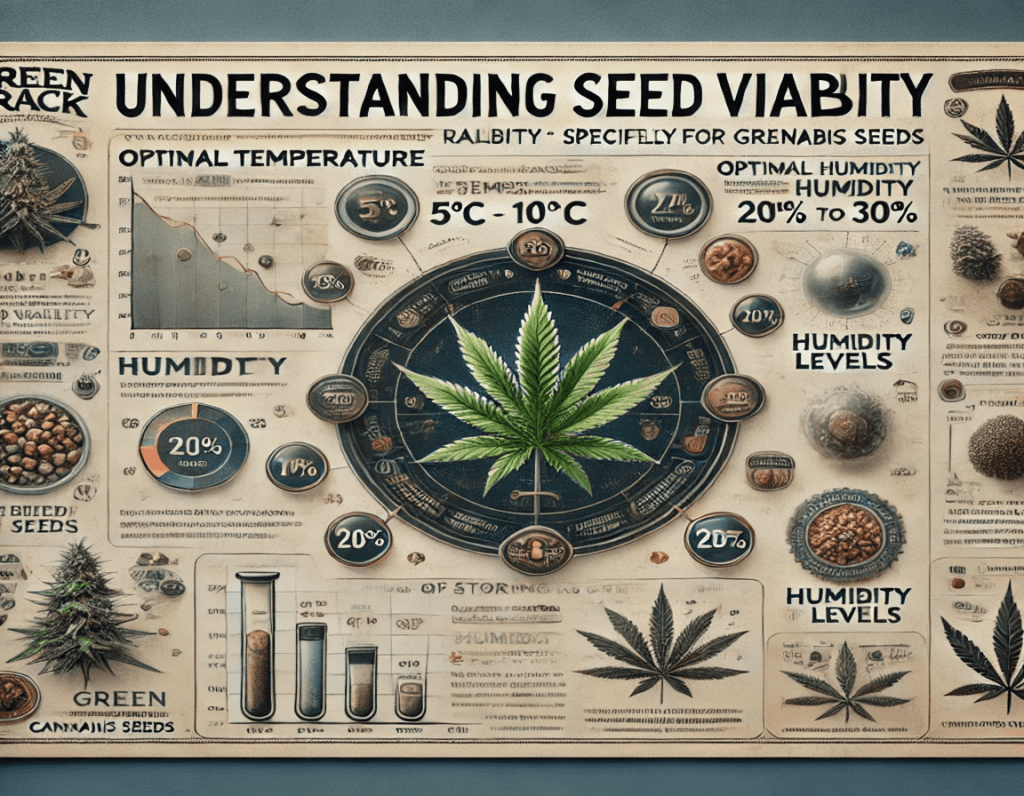
Proper seed storage is essential for maintaining the viability of your harvested Green Crack seeds. Viable seeds are those that have the potential to germinate and produce healthy plants. To ensure that your seeds remain viable for as long as possible, it’s crucial to understand the factors that influence seed longevity.
Temperature:
Seeds are sensitive to temperature fluctuations. Ideal storage temperatures are typically between 5°C to 10°C (41°F to 50°F). Higher temperatures can speed up the aging process, reducing the seeds’ viability over time. It is essential to keep the storage environment consistent, as temperature spikes can lead to moisture buildup and affect the seeds’ ability to germinate.
Humidity:
Excess moisture can lead to mold and seed rot. Maintaining a humidity level of 20% to 30% is optimal for seed storage. If the humidity level is too high, seeds can absorb moisture, leading to premature germination or decay. Conversely, if the air is too dry, seeds may lose their moisture content, affecting their ability to sprout.
Light Exposure:
Seeds should be stored in a dark environment to prevent premature germination. Light exposure can trigger the germination process even when conditions are not ideal. A dark storage space helps ensure that seeds remain dormant until you are ready to plant them.
By controlling these factors, you can significantly extend the shelf life of your Green Crack seeds.
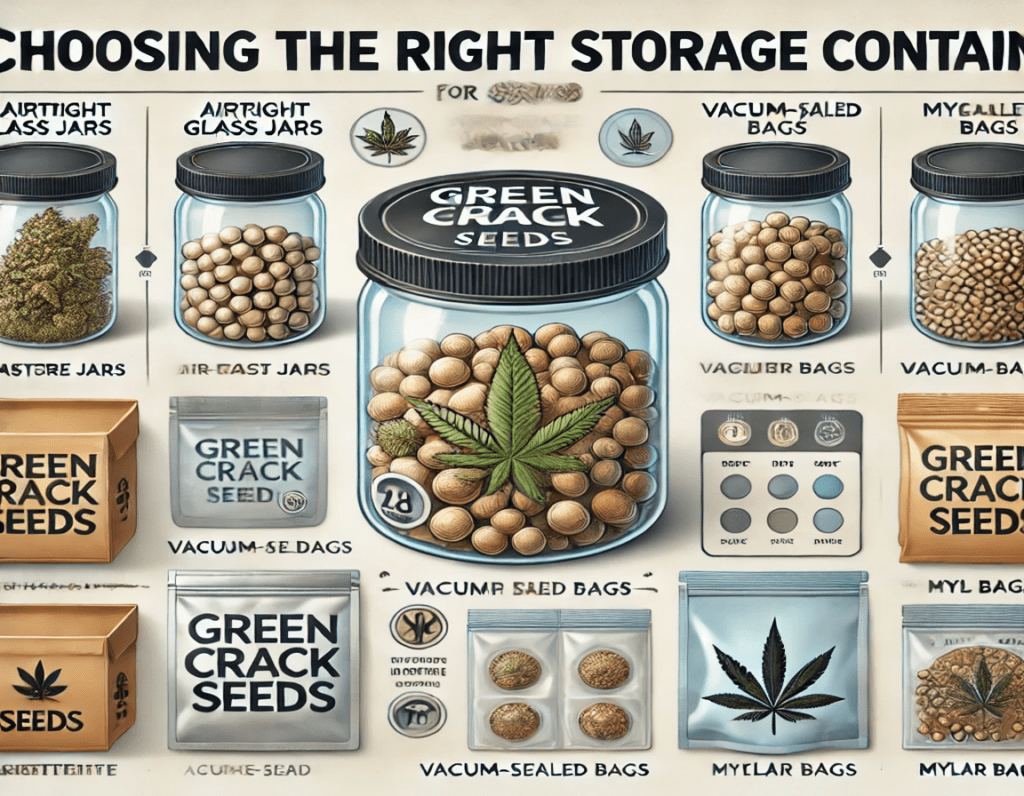
Selecting an appropriate container for storing your seeds is vital to maintaining their quality. The right container will protect your seeds from environmental factors like moisture, light, and air.
Using airtight containers is one of the best ways to store your seeds. Glass jars with tight-fitting lids, vacuum-sealed bags, or Mylar bags are excellent options. These containers help minimize exposure to moisture and air, preserving the integrity of your seeds.
Glass Jars:
Glass is a non-reactive material that helps protect your seeds from external elements. Ensure that the jar’s seal is intact to prevent air from seeping in. This method is especially useful for short- to medium-term storage.
Vacuum-Sealed Bags:
Vacuum-sealing your seeds removes air, creating a near-perfect storage environment. This method is particularly effective for those looking to store seeds for several years. Vacuum-sealed bags also protect seeds from light exposure.
Mylar Bags:
Mylar bags provide an excellent barrier against moisture and light. These bags are also puncture-resistant and can be sealed tightly, making them an ideal choice for long-term seed storage.
While plastic containers may seem convenient, they are often not the best choice for long-term storage. Plastic can allow small amounts of air to penetrate over time, which can lead to seed degradation. Instead, opt for more secure, airtight options to ensure the longevity of your seeds.
Creating the right environment for your seeds is essential for preserving their viability. Here are some best practices for storing your Green Crack seeds effectively.
Store your seeds in a cool, dark place, away from direct sunlight and heat sources. A dedicated seed fridge or a temperature-controlled room can provide a stable environment that minimizes temperature fluctuations.
Seed Fridge:
A small refrigerator dedicated to seed storage can maintain the ideal temperature without the fluctuations common in kitchen refrigerators. Make sure it’s free from odors, as some smells can permeate the containers and affect seed quality.
Cool Dark Areas:
If a dedicated fridge isn’t available, look for a cool basement or closet that maintains a consistent temperature. Use a thermometer and hygrometer to monitor the conditions regularly.
Consider using desiccants, such as silica gel packets, to control humidity levels within your storage container. These agents help absorb excess moisture, further protecting your seeds from mold and rot.
Silica Gel Packets:
Place a few silica gel packets in each storage container. These are widely available and can help maintain a dry environment. Be sure to replace them periodically as they can become saturated over time.
Hygrometers:
Invest in a small hygrometer to monitor humidity levels in your storage area. This tool can help you keep track of the moisture content and make adjustments as necessary.
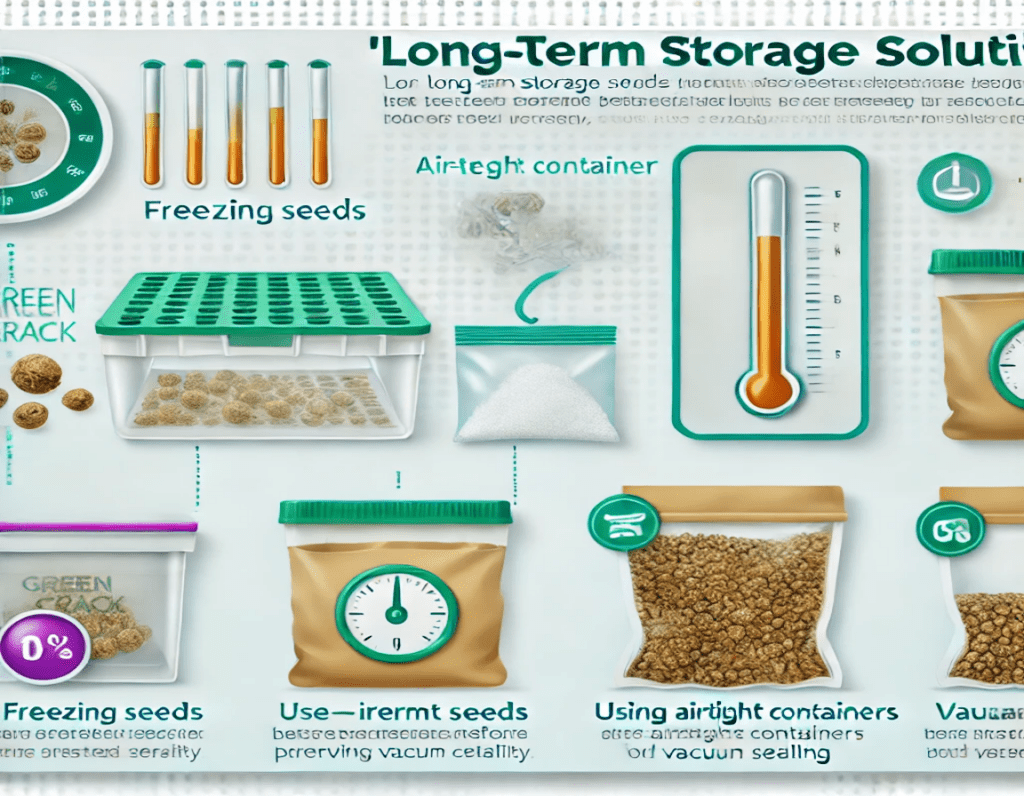
If you plan to store your Green Crack seeds for an extended period, consider these long-term storage solutions.
Freezing can be an effective method for long-term storage, but it requires careful preparation. Ensure your seeds are completely dry before placing them in airtight containers. When you’re ready to use them, allow the seeds to thaw slowly at room temperature to prevent condensation.
Preparation for Freezing:
Before freezing, spread the seeds out on a paper towel in a cool, dry place for a few hours to ensure they are completely dry. Once dry, pack them into airtight containers or vacuum-sealed bags to prevent moisture ingress.
Thawing Process:
When ready to use the seeds, take them out of the freezer and let them come to room temperature before opening the container. This process minimizes the risk of condensation forming on the seeds.
For shorter storage periods, refrigeration can be a viable option. Keeping seeds in the refrigerator maintains a stable temperature and reduces the risk of spoilage. Just be cautious of ethylene-producing fruits and vegetables, which should be stored separately to avoid damaging the seeds.
Storage in a Fridge:
Place seeds in a sealed container to prevent them from absorbing odors or moisture from the refrigerator environment. A dedicated drawer or shelf can also help keep them organized.
Avoid Ethylene Producers:
Keep seeds away from fruits and vegetables that emit ethylene gas, which can adversely affect seed quality. Store them in a separate area to maintain the integrity of the seeds.
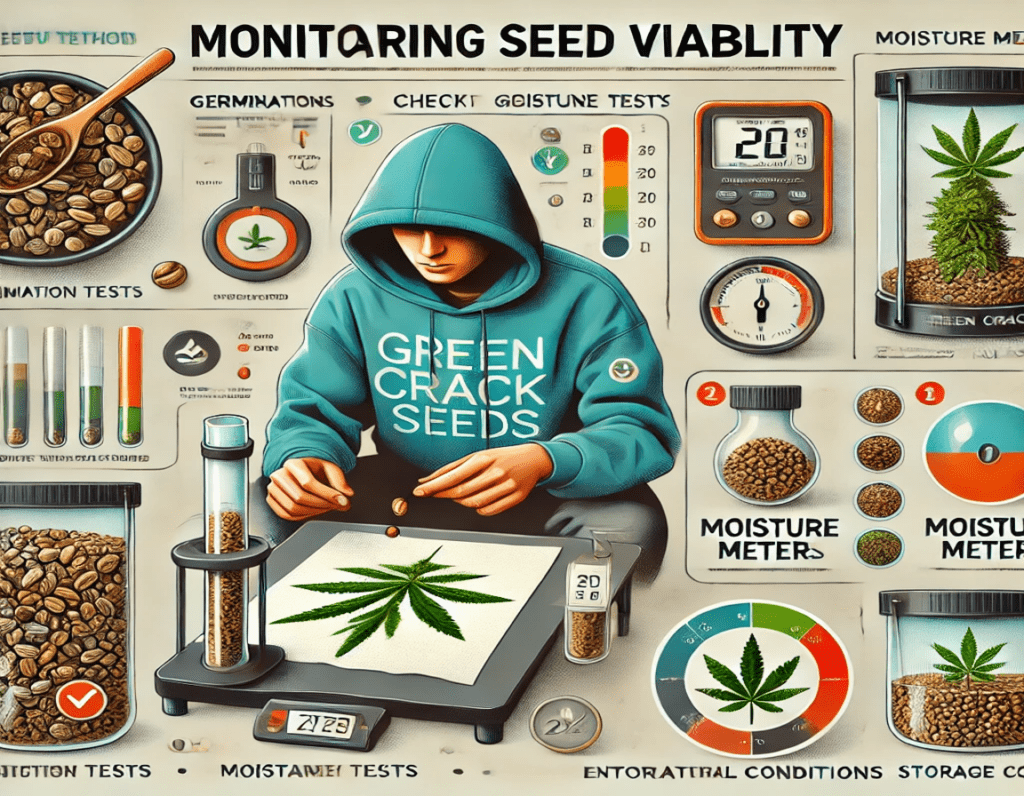
Regularly checking the viability of your stored Green Crack seeds is a good practice to ensure they remain capable of germination.
Conduct a germination test by placing a few seeds between damp paper towels. Keep the towels in a warm place and check for germination after a few days. If seeds sprout within 48 to 72 hours, they are still viable.
Conducting the Test:
Take a few seeds and place them on a damp paper towel. Fold the towel over the seeds and place it in a plastic bag to retain moisture. Check the seeds every day to monitor progress.
Assessing Viability:
If the seeds germinate, you can be confident in their viability. If not, it may be time to consider new seeds or adjust your storage methods.
Keep a record of the conditions in which you store your seeds, including temperature and humidity levels. This will help you identify any issues that may arise over time.
Maintenance Logs:
Maintain a log of temperatures and humidity readings. This can help you spot trends and adjust your storage methods if needed.
Regular Checks:
Schedule regular checks on your seed storage conditions to ensure that everything remains within optimal parameters.
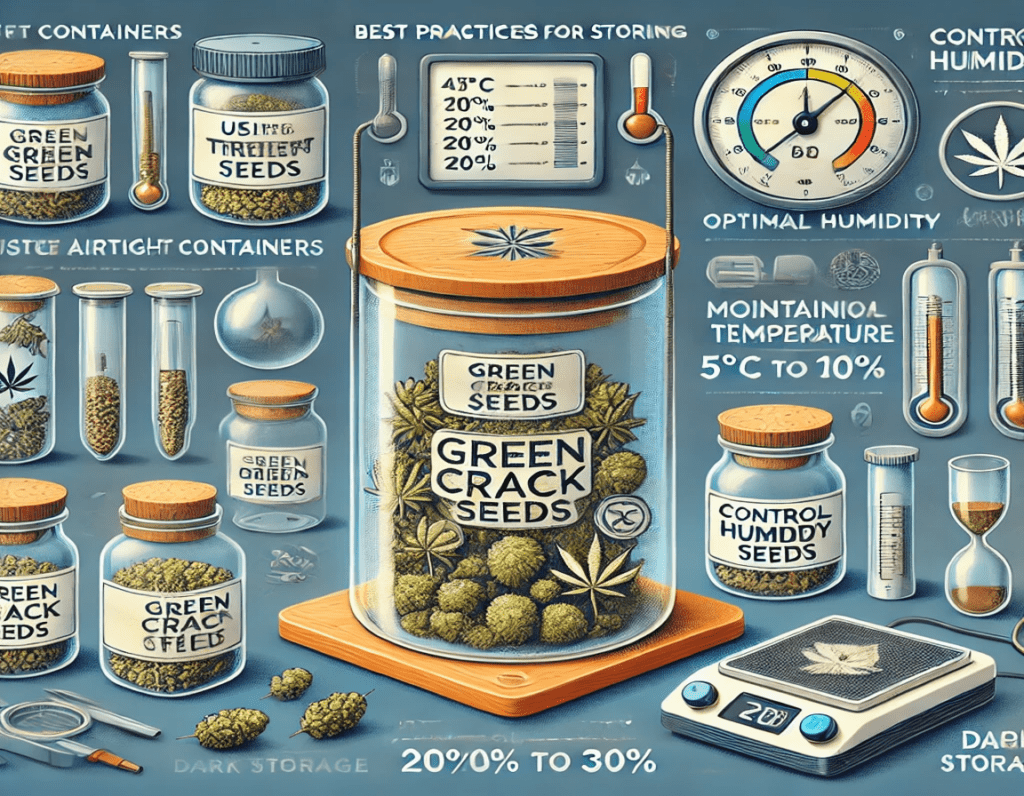
To summarize the best practices for storing your Green Crack seeds, consider the following tips:
Always store seeds in airtight containers, such as glass jars or vacuum-sealed bags, to minimize exposure to air and moisture.
Maintain ideal storage conditions with temperatures between 5°C to 10°C (41°F to 50°F) and humidity levels around 20% to 30%.
Keep seeds in a dark place to prevent light exposure that can trigger premature germination.
Conduct germination tests periodically to ensure that your seeds remain viable for future planting.
When stored properly in ideal conditions, Green Crack seeds can remain viable for up to 5 years or more.
The ideal storage temperature for Green Crack seeds is between 5°C to 10°C (41°F to 50°F).
Yes, refrigerating seeds can help maintain stable temperatures, but ensure they are kept away from fruits and vegetables that emit ethylene gas.
Conduct a germination test by placing seeds between damp paper towels and checking for sprouting within 48 to 72 hours.
It’s best to avoid plastic containers as they may allow air to penetrate. Opt for glass or vacuum-sealed containers instead.
We ship and deliver world wide via USPS and various couriers.
We offer a wide range of secure and anonymous online payment options.
We care about you, our customer. Please contact us with any questions or concerns.
Find out more about the benefits of being a loyal and regular customer.
WE ARE EVERY GROWERS ONE STOP SHOP TO ACQUIRE PREMIUM CANNABIS SEEDS FOR SALE IN THE USA, CANADA AND AUSTRALIA

Farmers Lab Seeds 2024, | All Right Reserved
Seeds are sold as novelty items, souvenirs, and collectibles. They contain 0% THC. We encourage our customers to check the legislation in their Country, State, Province, and Municipality prior to purchasing items from our store. We do not provide growing information.
All seeds are sold as hemp, and lab tested under 0.3% THC. This product is not for use by or sale to persons under the age of 21. This product should be used only as directed on the label. It should not be used if you are pregnant or nursing. Consult with a physician before use if you have a serious medical condition or use prescription medications. A Doctor’s advice should be sought before using this and any supplemental dietary product. All trademarks and copyrights are property of their respective owners and are not affiliated with nor do they endorse this product.
These statements have not been evaluated by the FDA. This product is not intended to diagnose, treat, cure or prevent any disease. Individual weight loss results will vary. By using this site, you agree to follow the Privacy Policy and all Terms & Conditions printed on this site. Void Where Prohibited by Law.